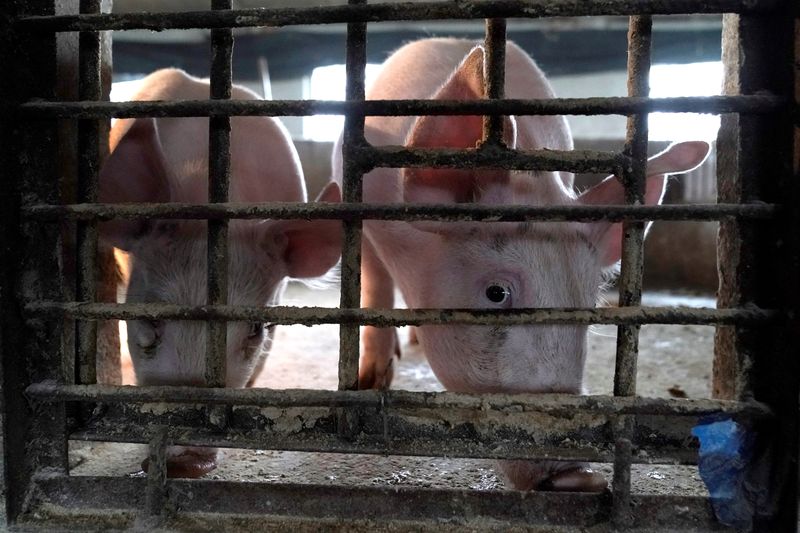BEIJING (Reuters) – Outbreaks of deadly African swine fever are surging in some parts of southern China following heavy rains, analysts and industry sources said, in what could be a big setback for Beijing’s goal of replenishing pork supplies.
China’s hog herd, by far the world’s largest, shrank last year by around 180 million pigs, or 40%, after the incurable disease decimated farms. Pig producers are building new farms and restocking amid the push to restore lost pork production and tame runaway meat prices.
But while African swine fever outbreaks have declined, partly due to smaller herds and better hygiene, the disease remains an obstacle to herd recovery. African swine fever is typically fatal for pigs but does not affect people.
Heavy rains and flooding across China’s south since mid-June appear to have triggered fresh cases, hurting restocking efforts, said Zheng Lili, chief analyst with consultancy Shandong Yongyi.
A Shandong Yongyi survey of small pig farmers, corporate farmers, traders and slaughterhouses in 20 provinces revealed dozens of African swine fever cases had occurred since the heavy rains in Guangdong province, the Guangxi region and other areas.
“Even the medium to large farms were hit,” said Zheng.
Farmers typically bury infected pigs, and the rains may have spread the disease via groundwater, analysts said.
The Ministry of Agriculture and Rural Affairs reported a dozen outbreaks of the fever in March and April, however, indicating it was spreading before the rains.
The last case reported by the ministry occurred in Yunnan on June 5. Many outbreaks, though, go unreported.
China’s agriculture ministry and the Guangdong government did not respond to faxes seeking comment on the disease’s resurgence. The Sichuan and Jiangxi governments could not be reached for immediate comment.
An official with the veterinary division under the agriculture bureau in Guangxi told Reuters by phone that they had not received any reports of African swine fever outbreaks lately in the whole region, including Laibin.
Pig inventories in Guangxi in the first half of the year rose 1.12% from the previous year, according to government statistics, the official added.
Graphic: China pork prices have risen after African swine fever decimated the country’s herd – https://fingfx.thomsonreuters.com/gfx/ce/yxmvjlxayvr/ChinaPorkPricesJuly102020.png
Sow inventories fell 3.87% in June from the previous month in southern China, while stocks in southwestern China, including Sichuan, Yunnan, Guizhou provinces and Chongqing, fell 3.04% from May, according to Zheng’s survey.
“If heavy rains continue throughout July, pig inventories in some provinces like Sichuan, Guangdong, Guangxi and Jiangxi, could fall as much as 20% by August from May,” Zheng said.
Live hog prices in the south have surged, with prices in Guangdong <JCI-HOG-GDONG> hitting 41.6 yuan ($5.96) per kg on Thursday, just shy of a record 43 yuan set last October.
Graphic: Hog prices in key provinces in China – https://fingfx.thomsonreuters.com/gfx/ce/qmyvmgwzwvr/ChinaHogPrices.png
Biosecurity measures at many farms in the south are not equipped to resist such rain, said an analyst based in Guangdong.
Restocking has “gone backwards” in some provinces, he said, with small pig farmers hit worse than larger facilities.
“We are extremely nervous,” said a farmer from Yulin in the Guangxi region who heard about the resurgence of the disease from a local feed dealer.
The farmer, whose farm was hit by the disease last year, just restocked with more than 70 sows this past March.
“All we can do is sterilizing,” she said over the phone. “The virus is very, very scary.”
($1 = 6.9849 yuan)
(Reporting by Hallie Gu and Dominique Patton; Additional reporting by Gavin Maguire and the Beijing Newsroom; editing by Tom Hogue and Jason Neely)























